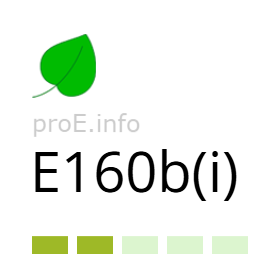
Other names for the additive (synonyms)
General Information
Food additive E160b(i) is a subtype of E160b (annatto extract). It represents a mixture of colorants obtained from the seeds of the annatto tree (Bixa orellana L.) by extracting the outer layer of the seeds with organic solvents – acetone, methanol, hexane, dichloromethane, or carbon dioxide.
After the removal of the solvent, two main pigments are obtained: bixin and norbixin. The latter is formed by hydrolysis of bixin in an aqueous alkaline solution.
Bixin (C25H30O4) is a fat-soluble dye with an orange-yellow hue. Norbixin (C24H28O4) is its water-soluble form, present as sodium or potassium salts.
The powder may also contain thermal degradation products, other plant components from annatto seeds, as well as residual impurities.
According to the requirements of Regulation (EU) No 231/2012, residual amounts of solvents (acetone, methanol, hexane) are permitted in food additive E160b at levels not exceeding 50 mg/kg in total, while the limit for dichloromethane is set at 10 mg/kg. In addition, the content of heavy metals is strictly limited: arsenic — not more than 3 mg/kg, lead — 2 mg/kg, mercury and cadmium — 1 mg/kg each.
The main use of additive E160b(i) is coloring dairy products (cheese, butter, margarine), sauces, snacks, and bakery products. The difference between this subtype and others is that it contains both fat-soluble and water-soluble forms of the pigment, making it the most versatile form of annatto extract.
Read more about the effects of annatto extracts on health, their applications, and legislation in the main article on additive E160b.